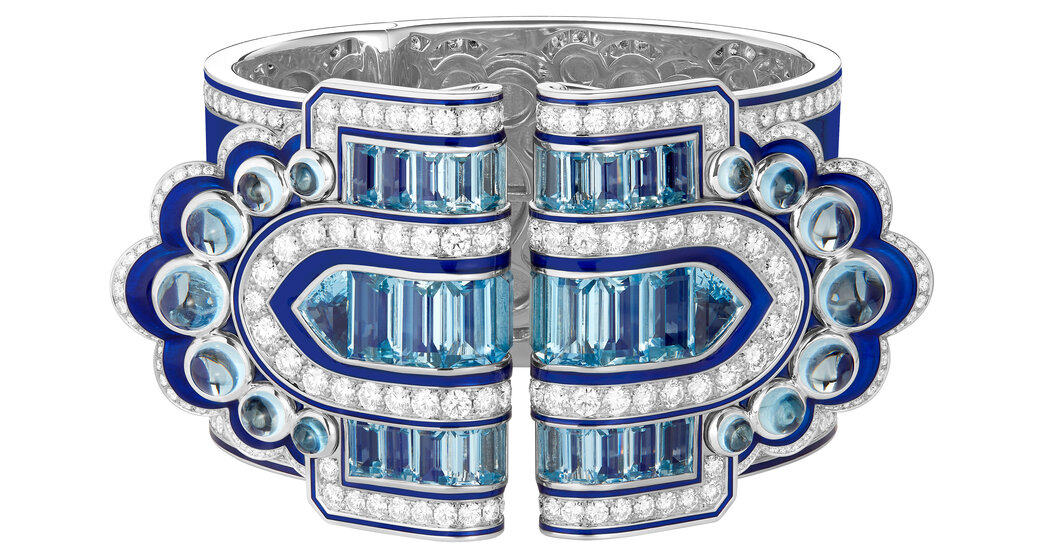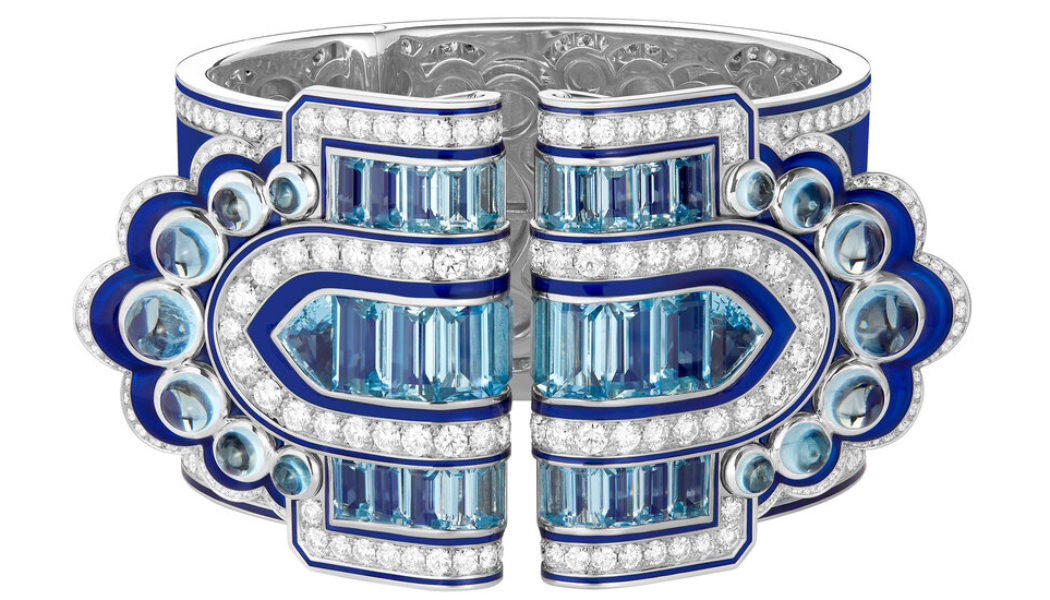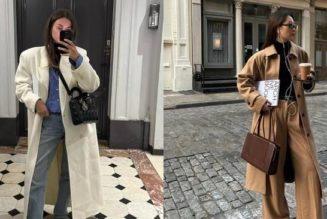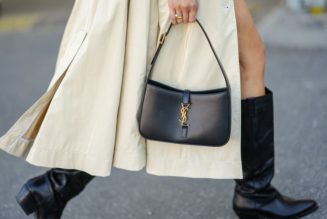
Houses find that their hoards of vintage pieces, design documentation and sbits of history can help drive sales.
A pair of diamond and aquamarine brooches given to Queen Elizabeth II on her 18th birthday was the inspiration for Boucheron’s latest Histoire de Style collection, a high jewelry line featuring reinterpretations of designs from the house’s archives.
The annual collection debuted in 2020 with a revival of Boucheron’s 19th century Question Mark necklace. This year, the creative director Claire Choisne wrote in an email, the contrast between “the strength and precision of Art Deco” and the “softness of the baby-blue aquamarine” guided her in designing the gem-laden necklaces, brooches, earrings and hair clips of the multipiece ensemble, titled Like a Queen.
A “synthesis of the archives,” as Ms. Choisne called the collection, is just one of the ways many jewelry houses are using their histories to drive sales. Some have hired specialists to organize records and buy back historically significant pieces to create their own in-house attractions, stock exhibitions and generally promote their heritage — all of which, experts say, attract buyers.
“A strong brand history references a brand’s superior quality and timelessness,” Sarah Willersdorf, Boston Consulting Group’s global head of luxury, wrote in an email, “these are the two most important attributes when purchasing luxury today.”
Boucheron’s archive traces its roots to 1921 when Louis Boucheron, the son of the house’s founder, began assembling a heritage collection that now comprises 800 pieces. But it was the current chief executive, Hélène Poulit-Duquesne, who identified the archives as a key driver for growth.
Since her arrival in 2015, “we have operated a more active acquisition strategy, with only one aim: collecting vintage pieces that reflect the richness of the maison history,” Ms. Poulit-Duquesne said during a recent brand presentation.
Pieces from the heritage collection are regularly showcased alongside new creations in “La Maison,” a small traveling exhibition most recently displayed in November in Saudi Arabia.
Luca Solca, a senior luxury analyst at the research firm Sanford C. Bernstein, wrote in an email that luxury brands monetized their archives by “using them for new reinterpretations and feed creativity” — and archives help brands to align themselves with the art world, where “value is disconnected from the cost of production.” (He joked that nobody would discuss the gross margin of the Mona Lisa.)
Bain & Company’s latest luxury report, released in November 2022, also referred to the convergence of luxury goods and art as an increasing trend, reflected in the record number of exhibitions organized by museums and jewelry houses themselves in 2022. (More displays of archival material are scheduled this year, as the Japanese pearl specialist Mikimoto celebrates its 130th anniversary, and Cartier creations linked to Latin American influences are shown in Mexico City.)
Another Cartier exhibition, “Cartier and Islamic Art: In Search of Modernity” — organized by both the Musée des Arts Décoratifs in Paris, where it was shown from late 2021 to early 2022, and the Dallas Museum of Art, which exhibited it in mid-2022 — jewels were displayed like artwork, alongside preparatory drawings, notes and images of design inspirations.
Cartier has been retaining items since its inception in 1847, but did not identify its archives as an asset until the 1970s, when they were reorganized. Then, in the 1980s, it formally began the process of buying back some of its most important creations for what it named the Cartier Collection, now comprising about 3,500 pieces.
During that process, Cartier rejected the idea of establishing its own museum, but it regularly lends jewels from the collection to museums. “We were convinced, and we still are, that a house museum would have never attracted as many visitors as do temporary exhibitions in museums,” Pierre Rainero, the house’s image, style and heritage director, said in a video interview.
In the 1990s, Cartier introduced Cartier Tradition, a division that repurchased pieces for restoration and then resale. Mr. Rainero said the division was meant to be an additional service for customers, but he acknowledged that it also had attracted new clients on its own. Similar collections of restored vintage pieces for sale are offered by Van Cleef & Arpels and Buccellati — all part of the booming global market for pre-owned luxury goods that Bain’s report estimated would total 43 billion euros ($45.6 billion) in 2022.
Unlike Cartier, Bulgari has opted for a permanent exhibition place, the DomusAurea, which displays a frequently updated selection of heritage pieces within its flagship Via Condotti store in Rome. And it recently expanded its “Serpenti Metamorphosis” exhibition as part of the celebration of the Serpenti design’s 75th anniversary, mixing archival pieces with commissioned art that references the house’s signature snake. In coming months the show is scheduled to visit 40 locations around the world.
In a phone interview, Lucia Boscaini, Bulgari’s brand curator, was candid about how such exhibitions bolster the brand’s equity, reassuring clients about the investment potential of its high jewelry. “Such exhibitions have a business dimension too, as they boost the value of our creations,” she said, “so much so that for us, it has become more difficult to buy back our pieces from auctions, especially Serpenti.”
For example, a diamond and ruby Serpenti necklace sold in November 2019 at Sotheby’s for 337,500 Swiss francs ($362,050) — almost triple its low sale estimate.
Bulgari’s archival drawings generally are kept at its headquarters in Rome so Lucia Silvestri, the house’s jewelry creative director, and her team can access them. But, “Mr. Bulgari taught me never to copy ourselves and to look at the archive with two eyes: one towards the past and one towards the future,” Ms. Silvestri said.
Archives also often play a role in training designers and artisans — and even reviving techniques, the chief executive of Chaumet, Jean-Marc Mansvelt, wrote in an email.
“It is not uncommon that when an old piece is bought back, our high jewelry workshop — while restoring it — rediscovers techniques that may have fallen into oblivion and that we want to bring back in a future creation.”
For example, he mentioned the recent reacquisition of the Radziwill tiara, a silver and gold piece that the house made in the 19th century. Restoring it, he said, required Chaumet’s artisans to learn traditional techniques of working silver. Work on other old pieces also led the atelier to practice serti écaille, a technique in which diamonds are set to layer over one another, like the scales of a fish. Chaumet used the style in Ondes et Merveilles, a collection presented in July 2022.
The materials that go into a piece of jewelry often are not the only determinator of its worth. “Value is many things,” Kristian Spofforth, head of the jewelry department at Sotheby’s London, said in a video interview. “It’s, of course, the gold, the diamonds, the gemstones, but the story plays an important role, too.” Besides illustrious provenance, adjacency to history is a potent selling factor, he said.
A deep connection to history begun in 1613 is what Mellerio dits Meller’s creative director, Laure-Isabelle Mellerio, showcased in the 2021 collection Les Muses, inspired by women like Marie de’ Medici and Marie Antoinette who had connections to the house.
The collection’s introduction prompted Ms. Mellerio to reorganize a selection of items from the house’s vast archive and display them in a small museum on the lower floor of the brand’s Rue de la Paix boutique. It includes the Marmotte, the trunk that Jean-Baptiste Mellerio carried on his back when selling jewelry on the streets of Paris and Versailles in the late 18th century.
“When clients see the Marmotte, they are flabbergasted,” Ms. Mellerio said in a video call, adding that the archival material roused enthusiasm for the brand. “It’s a discovery, it’s an experience, clients are immersed in the brand and immediately understand its DNA, its authenticity and appreciate it.”









